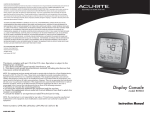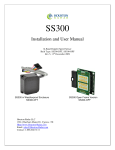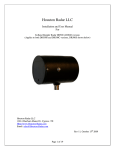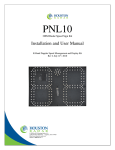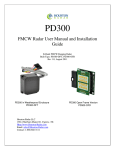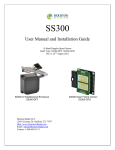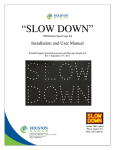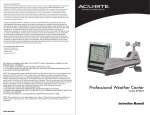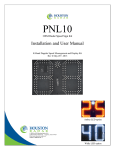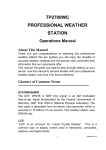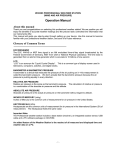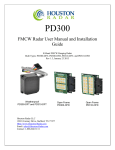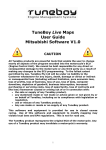Download DR1500 - Houston Radar
Transcript
DR1500 Installation and User Manual K-Band Doppler Speed Radar Built Type: DR1500-BOM2 Rev 2, April 15th 2009 Houston Radar LLC 13814 Sherburn Manor Dr. Cypress .TX Http://www.Houston-Radar.com Email: [email protected] Contact: 1-888-602-3111 Houston Radar DR1500 User Manual This device complies with part 15 of the FCC Rules. Operation is subject to the following two conditions: (1) this device may not cause harmful interference, and (2) this device must accept any interference received, including interference that may cause undesired operation. Changes or modifications not expressly approved by the party responsible for compliance could void the user's authority to operate the equipment. Any modification or use other than specified in this manual will strictly void the certification to operate the device. This device carries FCC modular approval and as such is labeled with FCC ID TIADR1500. If this label is not visible when the module is installed inside another device, then the outside of the device into which the module is installed must also display a label referring to the enclosed DR1500 module. This exterior label can use wording such as the following: “Contains Transmitter Module FCC ID: TIADR1500” or “Contains FCC ID: TIADR1500.” Any similar wording that expresses the same meaning may be used. Page 2 of 19 Houston Radar DR1500 User Manual Warning: DR1500 radar is supplied in an open frame format with exposed antenna and electronics and thus is a static sensitive device. Please use static precautions when handling. Warranty does not cover damage caused by inadequate ESD procedures and practices. Note: Specifications may change without notice. Note: Not liable for typographical errors or omissions. Page 3 of 19 Houston Radar DR1500 User Manual Table Of Contents INTRODUCTION............................................................................................................. 5 INSTALLATION.............................................................................................................. 5 MOUNTING: ..................................................................................................................... 5 DIRECTION POINTING:...................................................................................................... 6 RECOMMENDED ENCLOSURE FOR THE DR1500:.............................................................. 6 HOOKUP:.......................................................................................................................... 7 Power Input: ............................................................................................................... 7 Serial Connection: ...................................................................................................... 7 Measured Speed Output:............................................................................................. 7 Setting Detection Sensitivity via the ASCII Interface: ................................................ 7 Log/Statistics Storage: ................................................................................................ 9 HTTP://HOUSTONRADAR.COM/DOWNLOADS/HOUSTONRADARADVANCEDSTATISTICSWHITEPAPER.PDFWI RE SIGNAL DESCRIPTIONS:............................................................................................... 9 WIRE SIGNAL DESCRIPTIONS: ........................................................................................ 10 USE................................................................................................................................... 11 COLLECTING AND ANALYZING IN-RADAR TRAFFIC STATISTICS............ 11 REAL TIME TRAFFIC STATISTICS IN THE RADAR:......................................... 11 Internal Clock: .......................................................................................................... 13 Configuring the Unit:................................................................................................ 13 Setting Variables in the Radar:................................................................................. 15 DR1500 SPECIFICATIONS.......................................................................................... 17 GENERAL ....................................................................................................................... 17 APPROVALS ................................................................................................................... 17 DATA INTERFACES ......................................................................................................... 17 MECHANICAL ................................................................................................................. 17 PERFORMANCE ............................................................................................................... 18 APPENDIX A: HOOKING UP TO THE TRIGGER OUTPUT ON THE RADAR 19 Page 4 of 19 Houston Radar DR1500 User Manual INTRODUCTION Congratulations on your purchase of the Houston Radar directional Doppler Speed Radar DR1500. This state of the art 24GHz K-band microwave Doppler radar is specifically designed for the license free battery operated speed measurement and monitoring market. Utilizing high performance, ultra low power DSP (Digital Signal Processing) technology and microwave components based on a planar patch array antenna with integrated low power PHEMT oscillator, you will find that this high quality product meets your exacting standards for performance and reliability. Some of the highlights of this product include: Best in class low power usage of only 32 mA at 12VDC (0.38 Watt) Small and thin size to allow easy incorporation into your enclosure Advanced DSP based algorithm yields consistent performance and speed detection Typically up to 366 m (up to 1200 feet) of pickup distance for incoming vehicles on open and level road Two independent RS232 serial ports enhances connection flexibility One trigger output is capable of sinking 600 mA and is activated upon vehicle detection Radar internal software is upgradeable in the field via RS232 PC interface. Optional In-Radar advanced traffic statistics capability available All radar configuration parameters can be set by user via RS232 serial port. Extensive built-in self test. INSTALLATION Mounting: DR1500 is supplied in an “open frame” format. It requires a weatherproof enclosure before it may be used outdoors. Alternatively it may be mounted as a component in another product that already has a weatherproof enclosure. The DR1500 should be mounted such that the DB9 connector points left or right as shown in the picture on the front page. This results in maximum pickup range. The unit may be rotated 90degrees from the suggested optimal mounting. However, in this case, the detection range may be reduced by about 25%. Page 5 of 19 Houston Radar DR1500 User Manual Direction Pointing: The DR1500 is directional in nature. It only detects traffic in the incoming direction and rejects all traffic moving in the outgoing direction. If you wish to detect outgoing traffic, please contact us for more information. For optimal performance: Radar should be mounted as suggested in the section titled “Mounting” earlier Radar should be pointed into the direction of the oncoming traffic. Radar should be placed along the size of the road to minimize the angle of the oncoming traffic to the radar. o If radar cannot be placed right along the side of the road, it should be pointed at least 150+ m (500+ feet) up the road into oncoming traffic. The radar may pickup rotating fans. Avoid pointing it at fans or compressors. Radar should be mounted at least 1 m (3 feet) high from the road for optimal performance and at least 1.5 m (5 feet) off the ground for maximum pickup distance Recommended Enclosure for the DR1500: The DR1500 radar needs to be enclosed in a weatherproof enclosure for outside use. The following needs to be observed for optimal performance: 1. The front face of the radar (with the golden pads) is the antenna and is the face that must point into traffic. 2. Any cover or window in front of the unit MUST be at least 6mm (¼”) away from the face. 3. Do NOT spray any conformal (or other) coating, paint or other substance on the antenna. 4. The optimum material to use as a front window is Lexan (Polycarbonate) plastic. 5. The optimum thickness of this polycarbonate window is half wavelength of 24.125Ghz or about 3.5 to 3.7mm thick. a. Alternatively a thin window of any plastic material may be used. The maximum thickness in this case should be no more than 1 mm (40 mils). 6. Other plastic materials may be used as a front window, but the optimum thickness will wary with the material’s dielectric constant. Please contact us for details. 7. 6 mm (1/4” thick) Lexan is not recommended if you wish to obtain maximum pickup range. 4.7 to 5 mm (3/16”) thick Lexan is preferred in this case. Page 6 of 19 Houston Radar DR1500 User Manual Hookup: Power Input: The DR1500 radar should be powered from a nominal 12V DC source and features best in class operational power consumption of 32mA (nominal). This is world-class performance for a radar with this pickup range. This ultra low operational power translates directly into a longer battery life or gives you an option to power the unit from smaller batteries and smaller solar panels. Serial Connection: The DR1500 features two RS232 interfaces that may used to configure the unit as explained later in this document. Measured Speed Output: The DR1500 will send out the measured speed via the ASCII interface as a 3 digit speed with an optional direction indicator. The format is: [?,+]nnn[\r,\n] The format of the speed output can be adjusted to any combination of: “?”: Optional prefix sent when 000 selected to be sent when no vehicles are detected “+”: Optional prefix sent when nnn speed is sent for incoming vehicles “nnn”: Three digit ascii speed in the units selected via the UN variable “\r”: Carriage Return character, optional line ending “\n”: Line Feed character, optional line ending At least one or both of the line endings must be selected. No line ending is not an option. Please see serial port configuration section for details on how to select the above format. Setting Detection Sensitivity via the ASCII Interface: In addition through the supplied PC program interface, the radar also allows ASCII programmatic sensitivity setting. Over the serial interface, send in ASCII the following commands: Sensitivity:nn\n and Sensitivity?\n Page 7 of 19 Houston Radar DR1500 User Manual The fiirst command will set the detection sensitivity to "nn" where nn is from 10 to 99 and is a percentage of the maximum detection range. If sensitivity was set correctly, the unit replies with OK\n The second command will report sensitivity. Note 1: All settings, including sensitivity, are written to FLASH memory and are nonvolatile. DO NOT update settings on a periodic basis, e.g. every second or every minute. Only change settings when the user needs it. The FLASH memory has a limited number of write cycles and will wear out with excessive (>10,000) number of writes. On the other hand, setting the variable to the same value repeatedly is OK because the radar recognizes that the variable has not changed and does not update it in FLASH. Note 2: Other configuration parameters may also be set via ASCII interface. These are described in greater detail in our ASCII interface application note. Please contact Houston Radar for this document. Page 8 of 19 Log/Statistics Storage: The DR1500 radar has capacity to store traffic statistics in user programmable time bin intervals (default is 5 minute bins which yields 60 days of storage) and features a clock/calendar that retains time even when external power is removed. The clock is used to time stamp the collected statistics. The clock battery may not be installed in all build configurations. Please inform us in advance if you wish to retain this option. Stats are stored in mph or kph units. This depends on the display units of the stats. See the programming section to change the display units of the radar. This feature is an add-on software option. Please contact Houston Radar LLC for purchase of this option. Detecting traffic statistics inside the radar has tremendous advantages: Radar tracks multiple vehicles at different speeds simultaneously and hence does not miss vehicles visible to it Radar access to all return signal parameters of the target vehicles processed by proprietary software inside radar makes full use of every bit of information present in reflected signal and dramatically improves counting accuracy No add-on boards keeps total system power usage down and reliability up Advanced Statistics are software “key enabled” allowing turn-on in the field or after the radars have shipped to the sign manufacturer Easy Bluetooth wireless access using standard Bluetooth modules you buy from your source. Now enable statistics collection wirelessly! Please see a white paper on this topic on our web site for further discussion on this topic including some actual field test results. You may download it from the following URL: http://houston-radar.com/downloads/HoustonRadarAdvancedStatisticsWhitePaper.pdf Houston Radar DR1500 User Manual Wire Signal Descriptions: DB9 Pin # 1 2 3 4 5 6 7 8 9 Signal Name +12V DC Direction Description (wrt Radar) Input PRI RS 232 TX PRI RS 232 RX Output AUX RS232 RX GND AUX RS232 TX Panel Power Save Do not connect GND Input Radar + Power Supply. Connect to battery + 9.5VDC to +18VDC Primary RS232 transmit output from Radar Primary RS232 receive input. Required only if connected to PC to download stats from unit or setting sensitivity parameter Auxiliary RS232 RX Input Output System Ground. Connect to battery Auxiliary RS232 TX Output “Open Drain Output”. See Note 1. N/A Do not connect. Input System Ground. Connected to wire #5. Input Note 1: The DR1500 features an output that can wake up an external display panel(s) to bring it out of power saving mode when a vehicle is detected above a user set threshold. If the panels you hook to the radar do not feature such an input, this pin should remain unconnected. Normally this pin is pulled up to +12VDC by ~18KOhm resistor on the radar PCB. When a vehicle is detected, this pin is pulled down to GND and held down to GND as long as a vehicle is detected. This pin is released to +12VDC as soon as the radar detects no further traffic. You must ensure that no more than 600mA of current flows into this terminal when it is pulled low. Note: The mounting plate of the radar is connected to GND (i.e. pin 5 and 9). Page 10 of 19 Houston Radar DR1500 User Manual USE Turn on the power to the DR1500 to make it operational. No other action is required. The radar will activate the open drain outputs whenever it detects a vehicle that is above the programmed lower speed limit (the “LO” value) and below the programmed high limit (the “HI” value). The default limits are typically set at 5 mph (8 kph) and 99mph (158 kph) at the factory but may be different in your configuration. The programmed values are always included in the manufacturing test report sent with the radar. The values in brackets apply if units are set to KPH. The radar will also keep sending out the speed in user selected ASCII format over the serial interface while an incoming vehicle is tracked. Connect radar to PC RS232 serial port and use provided Windows configuration software to program the high speed limit (“HI” variable). The radar de-asserts the trigger outputs above this limit. If you do not wish an upper detection limit, set this value to 159. This will ensure that the upper limit is never reached regardless if the units are set to MPH or KPH. Set the “LO” variable to set the lower detection speed limit. The outputs will be deasserted for vehicles below this speed limit. The lowest value this may be set is 2 MPH (3KPH). Collecting and Analyzing In-Radar Traffic Statistics The DR1500 Radar supports optional “In-Radar” advanced traffic statistics collection. This feature is sold separately. If your radar has this feature enabled you may collect the stored statistics by using the provided Houston Radar Advanced Statistics Analyzer Windows program. This program must be installed on a MS Windows 2000, XP, Vista or Windows 7 32 bit operating system PC and allows the retrieval of stored statistics from the radar by using a PC serial port. It also has features to generate traffic reports, plot interactive graphs and export the raw data to a MS Excel file. Please refer to the on line help functionality of the program after you install it on your computer for detailed instructions on how to use its functionality. Real Time Traffic Statistics In the Radar: Page 11 of 19 Houston Radar DR1500 User Manual The DR1500 In-Radar stats software now features “real time” histogram statistics. These are updated as soon as a vehicle is detected and may be read out as a speed bin count “histogram”. Thus no historical records need be read out and parsed to read statistics. This feature requires a host program to be on-line to read the live statistics. Please contact Houston Radar for more information if you are interested in acquiring live statistics from the radar. Page 12 of 19 Houston Radar DR1500 User Manual Internal Clock: The radar has a built in clock/calendar function that is kept up to date with the installed Lithium coin battery when power is removed. The radar clock battery is only installed if you ordered the In-Radar traffic statistics feature or indicated to us that you wish to activate In-Radar traffic statistics at a later time. Configuring the Unit: The unit’s internal parameters may be configured by connecting the radar’s RS232 port to a PC’s RS232 serial port and using the Houston Radar Advanced Stats Analyzer program’s configuration screen as described here. The following internal “variables” may be set. Their functions are described below: Radar Configuration Variable Name RS RA UN Description Sets the primary RS232 serial port’s baud rate and output format. Do not change this value unless a value is provided by Houston Radar. Sets the auxiliary RS232 serial port’s baud rate. Sets the internal speed units of the radar. All LO, SP & HI speeds are interpreted to be in this units. 0 = MPH 1 = KPH (2 = feet/sec, 3 = meter/sec in firmware version >= 416) See “UN Note” below for new units in the latest version of the firmware LO HI SP ST SF BN Low speed cutoff. Vehicle speeds are not output below this speed. Minimum value is 2. Should be set to be less than HI. High speed cutoff. Vehicles speeds are not output above this speed. Maximum value is 159. Should be set higher than LO speed. Flashing speed limit. Any speed higher than this value flashes the trigger output at 2/3 duty cycle, 1Hz. Sending out 000 between nnn speed values also interrupts the speed output to signal “flashing”. Target detection sensitivity. Valid values are from 10 to 99 and are a percentage of max range. So a value of 50 would yield about 750 feet detection. Note: This is not range setting but detection sensitivity. Thus if large vehicles are being detected at 1200 feet, a value of 50 will make them detect at approx 600 feet etc. 1 = Select Fastest Target for speed output 0 = Select Strongest Target for speed output Set from 1 to 60 minutes of binning interval for stats collection. Traffic data binned (see below) and is accumulated for this duration in Page 13 of 19 Houston Radar DR1500 User Manual MO KY the bins and then a time stamped record made in stats memory in the radar. Speed bins are factory set and cannot be changed. They are: 5 MPH bins for MPH units (20 bins in total from 0 to 105 MPH) 10 KPH bins for KPH units (17 in total from 0 to 170 KPH) Radar mode bits mask. The bits controls speed output on primary and aux serial ports, rapid output update and other functionality. (bit 0 -> 0 = SI3 compatibility mode for ASCII commands) (bit 1 -> 1 = Enable ASCII output on primary serial port) (bit 2 -> 1 = Enable ASCII output on auxiliary serial port) Reserved. Do not set unless value provided by Houston Radar “UN” Note: Radar firmware version 416 and higher support the following additional units: (2) feet per second (fps) and (3) meters per second (mps). Additionally, the high byte of the UN variable controls the # of decimal points that is output on the ASCII speed. Up to 3 places of decimal may be output. Thus to set the radar to output in fps with 2 places of decimal, set UN to (2*256 + 3) 514. Page 14 of 19 Houston Radar DR1500 User Manual Setting Variables in the Radar: 1. Install the Houston Radar Advanced Stats Analyzer Windows program on a Windows 2000, XP or Vista computer. 2. Connect the radar RS232 port to the PC’s RS232 serial port. If the PC does not have a serial port you may buy a USB serial converter dongle (from BestBuy, Radioshack or any Internet store). 3. Power up the radar. Ensure the green LED on the PCB is flashing 4. Start the Houston Radar Stats Analyzer program 5. Click on Start->Connect to Radar… 6. Click on “Connect” button. 7. Ensure you see a “Radar found on COM” message. The COM # will depend on your computer 8. Click on OK. Now you are ready to configure the radar. 9. To configure the LO, SP & HI limits, click on “Radar Limits” menu bar item. The three fields show the current values of the three variables. Change the variables to the desired values and click on “Save”. 10. To configure any other variable, click on “Advanced->Radar Configuration”. In the window that comes up, enter the two letter variable name in the “Variable” field. Enter its value in the “Value” field and click on “Set Variable” button. Page 15 of 19 Houston Radar DR1500 User Manual Set Serial Baud Rate: The supplied Windows configuration program can auto detect the baud rate of the radar serial port. However if you wish to communicate with the radar from your electronics, the radar serial port may be configured to different baud rates. Baud Rate (bps) 1200 1200 1200 1200 # Data Bits 7 7 7 8 # Stop Bits 1 1 1 1 Parity Even Odd None None “RS” variable value 10 11 12 13 2400 2400 2400 2400 7 7 7 8 1 1 1 1 Even Odd None None 20 21 22 23 9600 9600 9600 9600 7 7 7 8 1 1 1 1 Even Odd None None 30 31 32 33 115200 115200 115200 115200 7 7 7 8 1 1 1 1 Even Odd None None 40 41 42 43 19200 7 1 Even 50 19200 7 1 Odd 51 19200 7 1 None 52 19200 8 1 None 53 Note: Many other combinations are available and may be selected via an Excel configuration tool. Please contact us for this tool. Page 16 of 19 Houston Radar DR1500 User Manual DR1500 SPECIFICATIONS General Operating Band Frequency Power Output Antenna Beam Pattern Polarization Supply Voltage Reverse Battery Nominal Current Draw Operating Temp. Weatherproof IR Remote Programmable K-Band 24.125 GHz ±50Mhz (US), 24.200Ghz on request 5mW 11deg x 11 deg Linear 8.7V DC to 18V DC Protected 32 mA avg. (+/-2ma,) (@+12V DC) -22°F to +185°F (-30°C to +85°C). Electronics designed and tested to –40C. No Optional. Contact us for details. Approvals Approvals FCC Part 15. Data Interfaces Serial Communication Data Rate Data & Pwr Connector 2x RS232 for configuration Baud Rates from 1200 to 115200 baud “DB9” female Mechanical Weight Dimensions Cable Exit Mounting approx 500 grams (approx 0.5 lbs) 3.7" W x 3.2" H x 0.9" D (9.5 x 8.3 x 2.3 cm) Right angle DB9 connector on PCB. Off the side. Four #4 (M3) holes in carrier plate Specifications continued on next page … Page 17 of 19 Houston Radar DR1500 User Manual Performance Resolution Accuracy Detection Range ±0.006 mph (internal) rounded to whole mph (kph) when output over serial port if no decimal point selected. Otherwise selectable from 1 to 3 places of decimal. ±0.5% of reading + 0.1mph Typically up to 366 m (up to 1200 feet) for compact vehicles on open and level road with radar mounted 1.5 m (5 feet) high and pointed straight into oncoming traffic. 450+ m (1500+ feet) for larger trucks, lorries and vehicles with inherently large radar cross-section. May vary with installation and road conditions. Detection range may be lower under adverse weather conditions such as heavy rain due to 24GHz microwave absorption in water. Detection range may be affected by type and thickness of radar window in front of radar face. Page 18 of 19 Houston Radar DR1500 User Manual Appendix A: Hooking up to the trigger output on the radar The DR1500 radar features one “open drain” output. This device can sink 600mA of DC current at up to 18VDC. However, this is a low impedance output, which means that you must externally limit the maximum current that will flow into this output to 600mA at the worst-case head voltage. There are two ways to ensure this: 1. Connect an output device that is rated to draw no more than 600mA at your supply voltage (+Vhead). This device can be powered up to 18VDC. For example, this can be a 12 VDC relay coil rated at more than 600 mA of coil current or a LED lamp or 2. Connect an external resistor in series with the output load and the O/P1 pin. The value of this external resistor should be calculated as follows (ohms law): R (in K Ohms)= (Vhead –Vload drop)/600 +Vhead +Vhead Load Method 1 Load rated to draw max of 600mA at +Vhead max Load Resistor Pin # 7 of DB9 Triggered on vehicle detection GND On Radar PCB Page 19 of 19 Load Method 2



















